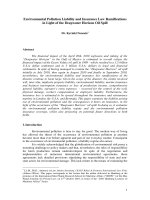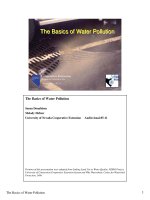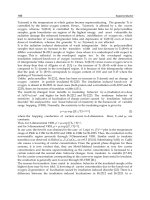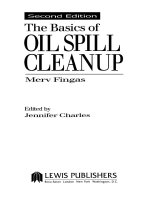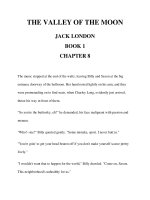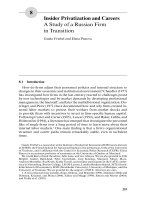The Basics of Oil Spill Cleanup - Chapter 8 pps
Bạn đang xem bản rút gọn của tài liệu. Xem và tải ngay bản đầy đủ của tài liệu tại đây (788.64 KB, 12 trang )
©2000 by CRC Press LLC
CHAPTER
8
Separation and Disposal
After oil is recovered from the water surface or from land, it must be temporarily
stored, the water and debris separated from it, and the oil recycled or disposed of.
Pumps are used to move the oil from one process to another. This chapter covers
temporary storage, separation, and disposal, as well as the types of pumps used for
oil. Storage, separation, and disposal are all crucial parts of a cleanup operation. In
several major cleanups, recovery has actually stopped because there was no place
to put the recovered oil.
When oil is recovered, sufficient storage space must be available for the recovered
product. The recovered oil often contains large amounts of water and debris that
increase the amount of storage space required.
Several types of specially built tanks are available to store recovered oil.
Flexible
portable tanks
, often constructed of plastic sheeting and a frame, are the most
common type of storage used for spills recovered on land and from rivers and lakes.
These are available in a range of sizes from approximately 1 to 100 m
3
and require
little storage space before assembly. Most of these types of tanks do not have a roof,
however, so rain or snow can enter the tank and vapours can escape.
Rigid tanks
,
which are usually constructed of metal, are also available but are less common than
flexible tanks.
Pillow tanks
, constructed of polymers and heavy fabrics, are usually used to
store oil recovered on land. These are placed on a solid platform so that rocks cannot
puncture the tank when full. Pillow tanks are also sometimes used on the decks of
barges and ships to hold oil recovered at sea. Oil recovered on land is often stored
in stationary tanks built for other purposes, and in dump trucks and modular con-
tainers, lined with plastic. Recovered oil can also be temporarily stored in pits or
berms lined with polymer sheets, although this open type of storage is not suitable
for volatile oils.
Towable, flexible tanks
, usually bullet-shaped, are also used to contain oil
recovered at sea. Their capacity varies but they can hold up to several tons. These
tanks are also constructed of polymers, with fabric materials sometimes used as a
©2000 by CRC Press LLC
base. Since most oils are less dense than water, these tanks will float throughout
the recovery process. When full, these tanks can be difficult to manoeuvre, how-
ever, and they can be difficult to empty, especially if the oil is viscous and contains
debris.
Oil recovered at sea is often temporarily stored in
barges
. Many cleanup orga-
nizations have barges that are used solely for storing recovered oil and lease barges
for use at larger spills. Recovered oil is also stored in the holds of ships, usually
using older vessels. This is more economical than using designated tanks on land
especially when the recovered oil has to be stored for long periods of time until a
final disposal method is found. Drums, small tanks, livestock watering troughs, and
even bags have also been used to contain oil from smaller spills, both on land and
at sea.
Pumps
Pumps play an important role in oil spill recovery. They are an integral part of
most skimmers and are also used to transfer oil from skimmers to storage tanks.
Pumps used for recovered oil differ from water pumps in that they must be capable
of pumping very viscous oils and dealing with water, air, and debris. The three basic
types of pumps used for pumping oil recovered from spills are centrifugal pumps,
vacuum systems, and positive displacement pumps. The operating principles of some
pumps are shown in Figure 26.
Photo 73
Temporary storage requirements can be overwhelming, as shown in this photo of
recovered oil in Japan. (Environment Canada)
©2000 by CRC Press LLC
Centrifugal Pumps
Centrifugal pumps have a spinning vane that moves the liquid out of a chamber
by centrifugal force. These pumps, which are regularly used for pumping water and
Photo 74
A flexible tank can sometimes be towed at high speeds, as shown here. (Foss
Environmental)
Photo 75
Portable tanks such as this are frequently used for temporary storage of recovered
oil. (Oil Spill Response Limited)
©2000 by CRC Press LLC
wastewater, are not designed for use with oil and are generally not capable of
dealing with material more viscous than light crudes, or with debris. They are
economical and universally available, however, and are often used in oil spill
cleanup operations.
Vacuum Systems
Vacuum systems consist of vacuum pumps and tanks mounted on a skid or
truck. The vacuum pump creates a vacuum in the tank and the oil moves directly
through a hose or pipe to the tank from the skimmer or the source of the oil. The
oil does not go through the pump, but moves directly from its source into the tank.
Vacuum systems can handle debris, viscous oils, and the intake of air or water.
The vacuum tank requires emptying, however, which is usually done by opening
the entire end of the tank and letting the material move out by gravity.
Figure 26
Operating principles of pumps.
©2000 by CRC Press LLC
Positive Displacement Pumps
Positive displacement pumps are often built directly into skimmers to recover
more viscous oils. These pumps have a variety of operating principles, all of which
have some common schemes. Oil enters a chamber in the pump where it is pushed
by a moving blade, shoe, or piston to the exit of the pump. The oil and other material
with it must move through the chamber because there is no alternative passage, thus
the name “positive displacement.”
The
screw
or
auger pump
is a common type of positive displacement pump.
The oil drops into part of the screw and is carried to an output. Wiper blades remove
oil from the auger flights to prevent it from remaining on the auger shaft. The screw
pump can deal with very viscous oils and is often built into skimmers. A
gear or
lobe pump
uses gears or lobes mounted on a shaft to accomplish the positive
displacement of oil through a chamber. Neither of these pumps can handle debris
or highly viscous oil.
The
diaphragm pump
uses a flexible plate or diaphragm to move oil from a
chamber. This type of pump usually requires a valve, which limits its use to material
that can pass through the valve making it unsuitable for oil containing debris.
A
vane pump
, which uses a movable metal or polymer plate to move oil in a
chamber, functions in a manner similar to a centrifugal pump, but with positive
Photo 76
This is a close-up of one type of screw pump. (Environment Canada)
©2000 by CRC Press LLC
displacement. The
peristaltic pump
uses a hose that is progressively squeezed by
rollers moving along the top of its surface. As the oil never comes into contact with
any material other than the hose, this pump is suitable for use with a variety of
hazardous materials. Both the vane pump and peristaltic pump can handle medium
viscosity oils and small debris.
A piston-like plunger in the
sliding shoe pump
moves oil along between the
input and output ports. This pump does not require valves, although certain models
do include them. The
piston pump
is similar to the sliding shoe pump except that
oil is simply pushed out of the cylinder from the input valve to the output valve.
Both sliding shoe and piston pumps can handle viscous oils, but generally cannot
handle debris.
Finally, the
progressive cavity pump
uses a rotating member inside a molded
cylinder that together form a cavity that moves from input to output as the centre
is rotated. This pump can handle very viscous oils and debris, but is heavy and more
expensive than other types of pumps.
Performance of Pumps
The performance of pumps is usually measured in terms of the volume displaced
per unit of time at a given viscosity, suction head, and pressure head. The suction
head is the maximum height that a pump can draw the target liquid and the pressure
Photo 77
This pump uses both vacuum and a positive displacement unit to move oil.
(Environment Canada)
©2000 by CRC Press LLC
head is the maximum height that a pump can push the target liquid. These heads
are not important in most applications of pumps in oil spill recovery. It is important,
however, that pumps used for pumping oil are self-priming rather than requiring that
a flow of liquid be established before the pump is functional. Other important factors
to consider are the pump’s ability to deal with emulsions and debris and the degree
of emulsion formation that takes place in the pump itself.
Separation
As all skimmers recover some water with the oil, a device to separate oil and
water is usually required. The oil must be separated from the recovery mixture for
disposal, recycling, or direct reuse by a refinery. Sometimes settling tanks or gravity
separators are incorporated into skimmers, but separators are more often installed
on recovery ships or barges. Portable storage tanks are often used as separators, with
outlets installed on the bottom of the tanks so that water that has settled to the bottom
of the tank can be drained off, leaving the oil in the tank. Vacuum trucks are also
used in this way to separate oil and water. Screens or other devices for removing
debris are also incorporated into separators.
A
gravity separator
is the most common type of separator. In its simplest form,
this consists of a large holding tank in which the oil and water mixture is held long
enough for the oil to separate by gravity alone. This is referred to as the “residence
time” and varies from minutes to hours. When inflow volumes are large, it can be
difficult to find large enough separators to provide the long residence times required.
Photo 78
This oil–water separator was built to operate on a barge. (Environment Canada)
©2000 by CRC Press LLC
Oil refineries have large separators that may cover several hectares and are used for
treating refinery waste and are sometimes also used to treat oil recovered from spills.
Separators are often made with baffles or other interior devices that increase the
residence time and thus the degree of separation. The
parallel plate separator
is a
special model of gravity separator. Many parallel plates are placed perpendicular to
the flow, creating areas of low water turbulence where drops of oil can re-coalesce
from the water and rise to the surface.
Centrifugal separators
have spinning members that drive the heavier water
from the lighter oil, which collects at the centre of the vessel. These separators are
very efficient but have less capacity than gravity separators and cannot handle large
debris. They are best suited to constant amounts of oil and water. Sometimes
centrifugal separators are used in tandem with gravity separators to provide an
optimal system.
As emulsions are not broken down in separators, emulsion-breaking chemicals
are often added to the recovered mixture before it enters the separator. Heating the
emulsions to 80 or 90°C usually results in separation and the water can then be
removed, although this process uses a lot of energy.
Separator performance is measured by the water removal efficiency and the
throughput volume. Important factors affecting performance include the ability to
handle small debris (larger debris is usually removed) and a wide variety of oil and
water ratios, with oil content and flow rate sometimes changing suddenly.
Disposal
Disposing of the recovered oil and oiled debris is one of the most difficult aspects
of an oil spill cleanup operation. Any form of disposal is subject to a complex system
Photo 79
Steel tanks are often used for both temporary storage and gravity separation of
water and oil. (Environment Canada)
©2000 by CRC Press LLC
of local, provincial or state, and federal legislation. Unfortunately, most recovered
oil consists of a wide range of contents and material states and cannot be classified
as simply liquid or solid waste. The recovered oil may contain water that is difficult
to separate from the oil and many types of debris, including vegetation, sand, gravel,
logs, branches, garbage, and pieces of containment booms. This debris may be too
difficult to remove and thus the entire bulk material may have to be disposed of.
Spilled material is sometimes
directly reused
either by reprocessing in a refinery
or as a heating fuel. Some power plants and even small heating plants such as those
in greenhouses can use a broad spectrum of hydrocarbon fuels. Often the equipment
at refineries cannot handle oils with debris, excessive amounts of water, or other
contaminants and the cost of pre-treating the oils can far exceed the value that might
be obtained from using them.
Heavier oils are sometimes sufficiently free of debris to be used as a
road cover
when mixed with regular asphalt. Recovered material from cleaning up beaches can
be used in this way. If the material is of the right consistency, usually sand, the
entire mixture might be mixed with road asphalt.
Incineration
is a frequent means of disposal for recovered oil as large quan-
tities of oil and debris can be disposed of in a relatively short time. Disadvantages
are the high cost, which may include the cost of transporting the material to the
facility. In addition, approval must be obtained from government regulatory author-
ities. Emission guidelines for incinerators may preclude simply placing material
into the incinerator. Spill disposal is sometimes exempt from regulations or special
Photo 80
Large stockpiles of recovered oil, debris, and beach material cause disposal
problems. Often these bags are disposed of in landfill sites and sometimes they
are incinerated. (Foss Environmental)
©2000 by CRC Press LLC
permits are available. Several incinerators have been developed for disposing of
either liquid or solid materials, but these all require special permits or authority
to operate. In remote locations, it may be necessary to burn oiled debris directly
on the recovery sites without an incinerator because it is too bulky to transport to
the nearest incinerator.
Contaminated beach material is difficult to incinerate because of the sand and
gravel content. Special burners have been constructed to process these materials and
the beach material can then be returned to the original site. There are also machines
to wash oily sand or gravel. The oil recovered from this process must be separated
from the wash water and then disposed of separately. Similarly, heat treatment
devices remove oil from sand or gravel without burning. The resulting vapours are
trapped, condensed, and the oil disposed of. This method is not common as it requires
large amounts of heat energy.
Incineration should be differentiated from in-situ burning, which involves burn-
ing the material directly on site without the use of a special device. This is usually
only applied to lightly oiled driftwood and special permission must be obtained from
the appropriate authorities.
Oiled debris, beach material, and sorbents are sometimes disposed of at
landfill
sites
. Legislation requires that this material not contain free oil that could migrate
from the site and contaminate groundwater. Some governments have standard leach-
ability test procedures that determine whether the material will release oil. Several
stabilization
processes have been developed to ensure that free oil does not con-
taminate soil or groundwater. One process uses quick lime (calcium oxide) to form
a cement-like material, which can be used on roads as a dust-inhibitor. Another form
of disposal is to process liquid oil in a bioreactor and thus attempt to break it down.
This is usually not successful because of the many slowly degraded components in
some oils.
Photo 81
Special incinerators such as this one have been built to deal with recovered oil
and debris. Such disposal must be approved by local authorities. (Environment
Canada)
©2000 by CRC Press LLC
Land-farming
is the application of oil and refinery waste to land where it
degrades. This practice is now banned in most jurisdictions since many oil compo-
nents do not break down and contaminants, such as metals and polyaromatic hydro-
carbons, are carried away from the site, often in groundwater.
Lightly contaminated water, less than 15 parts-per-million (ppm) by weight of
oil, can usually be returned to the water body from where it came. More-contami-
nated water may require further treatment in separators or at a municipal wastewater
treatment plant.
